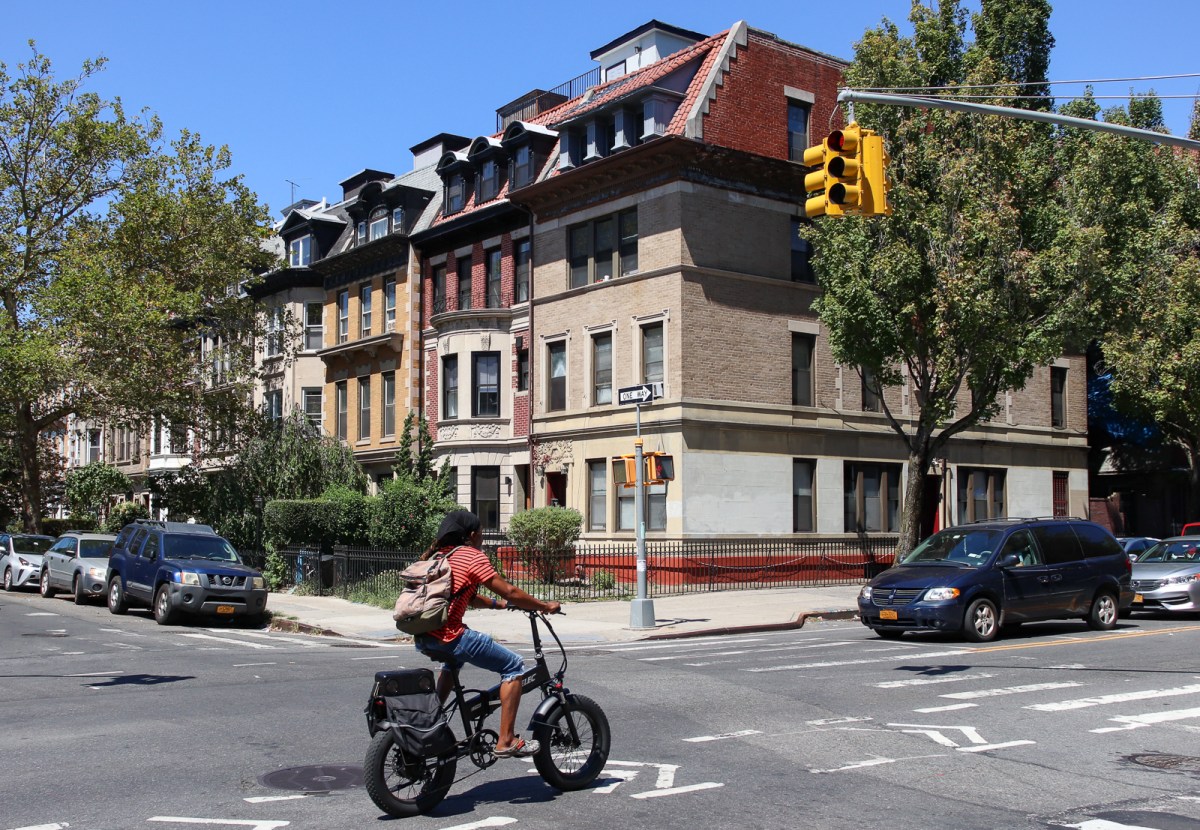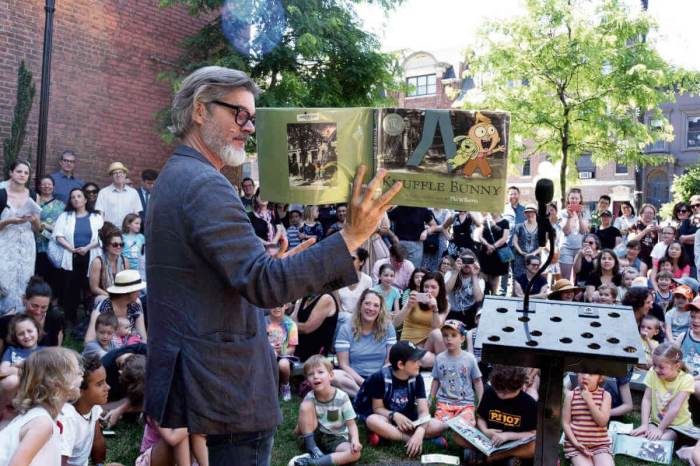By Julie Shapiro
Women work it at W.T.C.
Ashia Johns goes to work every day wearing a white hard hat on her head and a flashy white-gold diamond ring on her left hand.
The hard hat keeps her safe as she builds the new Goldman Sachs headquarters Downtown. The engagement ring look-alike, which Johns bought for herself, also keeps her safe — from the attentions of the dozens of men she works with.
“I wear the ring as a decoy,” Johns said, laughing as she ate lunch on the edge of the construction site on a recent afternoon. “They don’t really bother me,” she said of her male co-workers. “I just use [the ring] to throw them off.”
Johns, 35, is one of the rare women who choose carpentry as a career. For every 65 male carpenters, there is only one female carpenter, according to a 2008 U.S. Dept. of Labor study. Other trades are even more skewed toward men — in the same 2008 study, the most unbalanced of all professions in the country was bricklaying, which boasted only one woman for every 230 men.
On the whole, women represent 2.5 percent of the total workers in the construction and excavation industry, up from 2.1 percent 20 years ago, the Dept. of Labor said.
In Lower Manhattan, where so much construction has flooded the neighborhood that the city and state created a command center to keep track of it all, the numbers do not appear to be much different, though no one collects the statistics. Women at several large construction sites said they work with hundreds of men but just a handful of women.
The Lower Manhattan Construction Command Center runs several programs to attract women and minorities to work sites Downtown, including classes and job placement assistance.
“It’s not a man’s world anymore,” said Beverly Bobb, who manages the command center’s equal-opportunity programs. “If a woman can do it, why not?”
While Bobb said women remain very much in the minority and occasionally face harassment or poor work conditions, those who spoke to Downtown Express this month did not describe an atmosphere of negativity or discrimination. The biggest challenges of the job come not from their minority status but from the job itself, the women said.
Arlene Fisher, a surveyor at One World Trade Center, the Freedom Tower, said the most difficult thing she has to do is navigate the red tape associated with rebuilding ground zero.
“It’s different than any of the other jobs I’ve worked on,” Fisher said. “The chain of command is longer than normal… It takes 10 times as long to get anything done.”
Fisher, 39, spoke of her male co-workers with affection and a trace of condescension.
“Believe it or not, the guys on construction sites have good manners,” she said. Her one problem is that “They just don’t listen,” she said. “But most of the guys are well-trained,” she added. “They don’t like to see me get mad.”
Fisher, who is divorced and has two young children, started working in construction nine years ago after growing frustrated with her low-paying job as a special-education teacher. Now she spends most days outside, and on a recent afternoon she was using a laser to measure whether a concrete wall around the Freedom Tower’s core was perfectly straight and exactly where it was supposed to be.
Fisher and others described the salary — an average of nearly $50,000 a year for a full-fledged union member, plus benefits, according to a women’s advocacy group — as the biggest perk of the job.
The promise of good money drew Estelle St. Clair into a carpenters’ union in 1999, when she was out of work and had a 5-year-old son to care for.
“I did it at first for the income, but now a lot of the work fascinates me,” said St. Clair, who is building Tower 4 at the World Trade Center site. “Looking at the massive structures in New York, it makes you interested in how they get done, start to finish.”
On a recent morning, St. Clair, 35, strode across Tower 4’s partially completed floors with a pink bandana beneath her hardhat and the remnants of pink polish on her fingernails. St. Clair spoke with pride as she pointed out the recently poured concrete and the rows of steel reinforcements, then she worked with several men to build a structure that would support a new concrete floor for the next level up.
When St. Clair was first starting out in construction, some guys told her they wouldn’t work with concrete, because it was too dangerous. St. Clair was a little nervous, too, and she had to master her fear of heights so she could build skyscrapers.
“You’re outside in the fresh air, and there are new things to do every day,” St. Clair said. “Sometimes it’s a little scary.” She paused. “I love it,” she said.
St. Clair got so comfortable with being high up off the ground that on her last project, the Bank of America tower in Midtown, her supervisor had to remind her whenever she got too close to the edge of the building — she was so absorbed in her work that she barely noticed.
As for the men she works with, St. Clair said she rarely has problems.
“Sometimes at first, on a new job, they’ll say, ‘Can we ask her to do this? Is she willing?’” St. Clair said. “But once they see you jump in and you try, everyone loosens up some.”
Tanya Ridley, a metal lather and the only other female hard hat at Tower 4, said her favorite part of the job is its hands-on usefulness.
“You work hard, you get dirty, you know it’s worth it,” she said, grinning.
Ridley, 32, said she doesn’t mind being one of the only women on the site, and the men she works with don’t seem to mind either.
“If I’m not as strong as they are physically, I’m willing to work hard to get it done, just like anyone else,” she said.
Ridley initially worked as a secretary and a receptionist after high school, unaware that construction was even an option. Women are funneled into college, the military or low-paying, unrewarding jobs like home healthcare, she said, when the building trades might be a better fit.
Ridley may never have broken into construction at all, but two years ago she heard about a Chelsea group called Nontraditional Employment for Women.
NEW runs six-week training programs designed to launch women into careers in construction and other building, transportation and energy trades. Participants brush up on math skills, learn to read blueprints and practice toting 63-pound buckets up flights of stairs. NEW trained nearly 500 women last year, most of them lower-income minorities, and has been encouraging women to work in construction since 1978. Ridley did the program in 2007 and said it gave her the skills she needed to get a union job.
“Things are changing,” said Kathleen Culhane, vice president of programs at NEW. “Doors are opening like never before… . Today, it’s not such a rarity to see not only one woman but a handful of women on a job site, working in construction.”
On a Friday afternoon last month, NEW held a graduation for 12 women who had just completed the six-week program. The brief but boisterously heartfelt ceremony took place on the third floor of NEW’s W. 20th St. building, beneath posters reading “Celebrate Men Working With Women” and images of NEW’s logo, which looks like the symbol for “female” with a hammer instead of the “T.”
As each woman’s name was called to receive a completion certificate, the others cheered, making up for the lack of friends and family members in the very small audience.
(Before the ceremony started, one of the NEW leaders asked if any of the women were waiting on a guest. “It’s just us,” one of the students replied. Pointing to her fellow graduates, she added, “My guest is right here.”)
After impromptu speeches that left nearly everyone in tears, the graduates ate pizza and reflected on the demanding six weeks behind them and their plans for the future.
Taja Brown, 28, hopes to join a union so she can continue working in construction but get paid better wages. When she was 19, she helped her father fix up a house, and she fell in love with the work. Since then, she’s been getting jobs wherever she can.
“I like the looks I get in Home Depot,” Brown said, especially when she’s picking out an unusual tool or material. “People stare, like, ‘What do you know about that?’”
Brown once picked up a customer that way — a man saw her looking at tools in the tiling section, and she wound up tiling his entire basement. Brown has gotten some tiling jobs partly because she’s female, since customers expect her to be more detailed and precise, she said.
“But a lot of people assume I can’t do it,” Brown added. “I like to show them and prove them wrong.”
There is no typical NEW student. Other members of the graduating class included Cerise Bunch, a freckled 40-year-old woman from the Bronx, and Ruth Zuniga, a 20-year-old from Spanish Harlem. Bunch has an engineering degree but can’t find a job, so she decided to give the blue-collar industry a shot. She hopes to work for Con Edison or the Fire Dept. Zuniga had to complete her G.E.D. so she could apply to NEW, and now she wants to work as a bricklayer.
One of the only parents to attend the graduation was Stephanie Spencer, whose daughter Rashida Johnson, 26, had just completed the program. Johnson graduated collage and had worked in public relations but was laid off, her mother said.
“It’s wonderful that she’s getting a chance to go out there in the world and compete with guys,” Spencer said. “Women coming into construction, electrical, plumbing work — this is the last frontier, so good for them.”
Julie@DowntownExpress.com



































